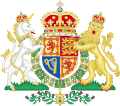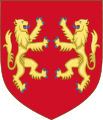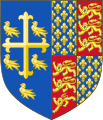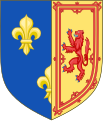United Kingdom coat of arms
| United Kingdom coat of arms | |
|---|---|

|
|
| Details | |
| Introduced | 1837 |
| Shield shape and division | Shield quartered |
| Heraldic shield | 1st and 4th England , 2nd Scotland , 3rd Ireland |
| Crown of rank | Edward's Crown |
| Sign holder | Lion and unicorn |
| Motto (motto) | Dieu et mon droit |
The coat of arms of the United Kingdom of Great Britain and Northern Ireland is the coat of arms of Queen Elizabeth II and a symbol of royal rule.
history
The royal coat of arms, which is also the government coat of arms in a slightly modified, less splendid form, has existed in this form since Queen Victoria ascended the throne in 1837 . Already with the Anglo-Scottish personal union in 1603 a similar form of the coat of arms was created.
Only with the unification of Great Britain and Ireland in 1801, which was reflected in a reorganization of the symbols in the coat of arms, did the French lilies , which had been used since 1340 in various forms because of a claim to the French throne, disappear .
description
The coat of arms is four and shows the parts of the country:

|
1st and 4th field | Left ( heraldic right ) above and right ( heraldic left ) below the coat of arms of England : three golden, blue armored “leopards” (striding lions) on a red background. |

|
2nd field | Right above the coat of arms of Scotland : a red Scottish lion surrounded by a red double lily border on a gold background. |

|
3rd field | Below left the coat of arms of Ireland : a golden harp on a blue background, which symbolizes Northern Ireland (until 1927 all of Ireland). |
The Order of the Garter surrounding the coat of arms with the motto of the Order: Honi soit qui mal y pense ( . French , mutatis mutandis "Shamed be he who thinks bad about it"). On the shield a spangenhelm with the St. Edwards crown sitting on it . On the crown is the crowned English lion running to the right.
The coat of arms is held in place by two shield holders . The heraldic bearer of the coat of arms, a crowned lion , stands for England . The heraldic left coat of arms , a silver unicorn , symbolizes Scotland . The unicorn is chained because in the Middle Ages the unicorn was thought to be a dangerous animal that could only be tamed by a virgin .
The piece of lawn, on which the shield, coat of arms and coat of arms are placed, is decorated with a banner with the motto of the English royal family: Dieu et mon droit (French, "God and my right"). Above the banner symbols for England ( Tudor roses ), Scotland ( thistles ) and Ireland ( shamrocks ).
Modified versions

The government uses the same coat of arms, but without a helmet and helmet decorations, there is also a Scottish version of the government coat of arms; the crown is located directly on the coat of arms.
When the Queen is in Scotland, she uses the Scottish version of the royal coat of arms (see coat of arms of Scotland ), in which the main changes compared to the English are the exchange of symbols of the Order of the Garter for those of the Scottish Thistle Order and the exchange of the English and Scottish fields in the coat of arms .
The Canadian coat of arms is also a modified version of the British one, with the addition of Canadian and French national symbols.
The coat of arms of the Commonwealth of England (1653 and 1659, not the Commonwealth of Nations ) can also be described as a modified version of the British coat of arms , even if it did not look very similar to today's. It was based on the royal coat of arms: the helmet and crest had been retained, and the coat of arms symbols of England and Scotland - the Irish harp was retained - were simply replaced by the corresponding flag symbols ( St. George's Cross for England, St. Andrew's Cross for Scotland). In the heart shield (shield in the middle of the coat of arms) was the coat of arms of the Lord Protector Cromwell , a silver soaring lion on black. Shield holders were a lion and a dragon, the motto "pax quaeritur bello" (German "Peace is sought through war"), a fitting motto for a regent who waged so many wars.
History of the coat of arms of Great Britain
The coat of arms of the Kingdom of England
The use of three golden leopards on a red background in the coat of arms of England goes back to the younger coat of arms of Richard the Lionheart , which has its origins in the coat of arms of the House of Plantagenet . To assert claims to the French throne , Eduard III. additionally the lilies of the Capetians included in the coat of arms. From 1406 the lilies were adapted to the current depiction in the coat of arms of France . Richard II also included the alleged coat of arms of Edward the Confessor . Maria I also used the coat of arms of her husband Philip II of Spain.
1154–1198
Possible depiction of the coat of arms of Henry II and the older coat of arms of Richard the Lionheart as kings of England1154–1198
Possible depiction of the coat of arms of Henry II and the older coat of arms of Richard the Lionheart as kings of England1198–1340
1360–1369
Younger coat of arms of Richard the Lionheart as King of England and his successors1395–1399
coat of arms of Richard II.1422–1461
1470–1471
Coat of arms of Heinrich VI.1554–1558
coat of arms of Maria I.
Coat of arms of the Kingdom of Scotland
The coat of arms of Scotland goes back to William I (Scotland) . Maria Stuart also used the coat of arms of her husband Franz II of France .
1558–1558
coat of arms of Maria Stuart before the accession to the throne of Francis II.
Coat of arms of the Kingdom of Great Britain, the Commonwealth of England, the United Kingdom of Great Britain and Ireland, and the United Kingdom of Great Britain and Northern Ireland
Since the accession to the throne of James I in England, who was previously King of Scotland, a common coat of arms has been used, in which the harp for Ireland was also included. There was usually a special version of the coat of arms for use in Scotland, in which the Scottish national symbols are given preference. In the Act of Union in 1707 , this was guaranteed. In the time of the Commonwealth of England , coats of arms based on the flag of England and the flag of Scotland were used. The exact representation was always subject to the respective fashions. So z. Due to the personal preference of Elizabeth II , for example, a simple Gaelic harp has recently been preferred to the older representation with the winged woman's head for the representation of the harp.
1655–1660
Commonwealth of England, Scotland and Ireland with Oliver Cromwell's personal coat of arms1689–1695
coat of arms under Maria II. And Wilhelm III.1689–1695
coat of arms under Maria II. And Wilhelm III.
(Scottish version)1694–1702
coat of arms under Wilhelm III.1694–1702
coat of arms under Wilhelm III.
(Scottish version)1707–1714
Coat of arms according to the Act of Union 17071714–1801, in the lower part of the fourth field a Saxon horse , in the heart of which there is an image of the imperial crown of the Holy Roman Empire
1801–1816, the coat of arms crowned with an electoral hat , in the center a reproduction of the imperial crown of the Holy Roman Empire
Web links
- Description of the coat of arms on the homepage of the British Monarchy
- Coat of arms of england
- Coat of arms of Scotland
- Commonwealth of England
- Royal Coat of Arms of the United Kingdom (Wikipedia)
- Coat of arms of the House of Plantagenet (Wikipedia)
- Shield holder of the royal coat of arms of England (Wikipedia)
































